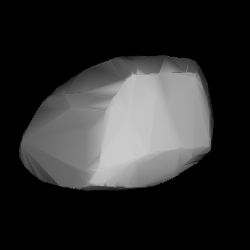116 Sirona
Appearance
(Redirected from (116) Sirona)
 3D convex shape model of 116 Sirona | |
| Discovery | |
|---|---|
| Discovered by | Christian Heinrich Friedrich Peters |
| Discovery date | 8 September 1871 |
| Designations | |
| (116) Sirona | |
| Pronunciation | /ˈsɪroʊnə/ |
Named after | Đīrona |
| A871 RA; 1954 UC3; 1998 EK13; 1998 ES21 | |
| Main belt | |
| Orbital characteristics[1] | |
| Epoch 31 July 2016 (JD 2457600.5) | |
| Uncertainty parameter 0 | |
| Observation arc | 143.31 yr (52345 d) |
| Aphelion | 3.1616 AU (472.97 Gm) |
| Perihelion | 2.37322 AU (355.029 Gm) |
| 2.76741 AU (413.999 Gm) | |
| Eccentricity | 0.14244 |
| 4.60 yr (1681.5 d) | |
Average orbital speed | 17.81 km/s |
| 7.59231° | |
| 0° 12m 50.724s / day | |
| Inclination | 3.5635° |
| 63.724° | |
| 94.932° | |
| Earth MOID | 1.38451 AU (207.120 Gm) |
| Jupiter MOID | 1.83156 AU (273.997 Gm) |
| TJupiter | 3.321 |
| Physical characteristics | |
| Dimensions | 71.70±5.8 km |
| Mass | 3.9×1017 kg |
Equatorial surface gravity | 0.0200 m/s2 |
Equatorial escape velocity | 0.0379 km/s |
| 12.028 h (0.5012 d)[1][2] | |
| 0.2560±0.047 | |
| Temperature | ~167 K |
| S | |
| 7.82[1][2] | |
116 Sirona is a somewhat large and bright-colored main-belt asteroid that was discovered by the German-American astronomer C. H. F. Peters on September 8, 1871, and named after Sirona, the Celtic goddess of healing.[3]
This body is orbiting the Sun with a period of 4.60 years and an eccentricity (ovalness) of 0.14. The orbital plane is inclined by 3.56° to the plane of the ecliptic. The cross-section diameter of this object is ~72 km. Photometric observations of this asteroid gave a light curve with a period of 12.028 hours and a brightness variation of 0.42 in magnitude.[2] It has the spectrum of an S-type asteroid, suggesting a siliceous composition.
References
[edit]- ^ a b c Yeomans, Donald K., "116 Sirona", JPL Small-Body Database Browser, NASA Jet Propulsion Laboratory, retrieved 12 May 2016.
- ^ a b c Zeigler, K. W.; Florence, W. B. (June 1985), "Photoelectric photometry of asteroids 9 Metis, 18 Melpomene, 60 Echo, 116 Sirona, 230 Athamantis, 694 Ekard, and 1984 KD", Icarus, vol. 62, pp. 512–517, Bibcode:1985Icar...62..512Z, doi:10.1016/0019-1035(85)90191-5.
- ^ Schmadel, Lutz D. (2003), Dictionary of Minor Planet Names (5th ed.), Springer, p. 26, ISBN 3540002383.
External links
[edit]- 116 Sirona at AstDyS-2, Asteroids—Dynamic Site
- 116 Sirona at the JPL Small-Body Database
